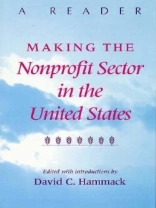‘It is a delight to seen an anthology on nonprofit history done so well.’—Barry Karl, John F. Kennedy School of Government, Harvard University
‘This is a volume that everyone concerned about nonprofits—scholar, practitioner, and citizen—will find useful and illuminating.’—Peter Dobkin Hall, Program on Non-Profit Organizations
Yale Divinity School
‘A remarkable book.’—Robert Putnam, John F. Kennedy School of Government, Harvard University
[One to come from John Simon, School of Law, Yale University by Jan. 13th and others are being solicited.]
Unique among nations, America conducts almost all of its formally organized religious activity, and many cultural, arts, human service, educational, and research activities through private nonprofit organizations. Though partially funded by government, as well as by fees and donations, American nonprofits have pursued their missions with considerable independence. Many have amassed remarkable resources and acquired some of the most impressive hospital, university, performing arts, and museum facilities in the world. While some have amassed large endowments, many that surpass one billion dollars, there are also hundreds of thousands of small nonprofits, most with no tangible resources at all.
How did the United States come to rely so heavily on nonprofits? Why has it continued to do so? What purposes do Americans seek to advance through nonprofits? How have Americans sought to control them? How have nonprofits been effected by the growth of government in the twentieth century? These questions suggest the complexity of the history of nonprofits in the United States. To help explore that history, this reader presents some of the classic documents in the development of the nonprofit sector along with important interpretations by recent scholars. The selections can be considered a representative part of a single extended conversation by the men and women who have taken part in the effort to define America and the American dream, even as they shaped what we now call the nonprofit sector. The statements by participants in the growth and development of the nonprofit sector are accompanied by essays written by historians and social scientists that provide concise surveys of important issues and periods. The essays give voice to those whose contributions to the American debate about voluntary associations and private institutions would otherwise be difficult to find or comprehend.
The selections can be considered a representative part of a single extended conversation by the men and women who have taken part in the effort to define America and the American dream, even as they shaped what we now call the nonprofit sector. The statements by participants in the growth and development of the nonprofit sector are accompanied by essays written by historians and social scientists that provide concise surveys of important issues and periods. The essays give voice to those whose contributions to the American debate about voluntary associations and private institutions would otherwise be difficult to find or comprehend.
Each selection has been chosen to define or illuminate important questions in the development of the nonprofit sector in the United States. Many include criticisms of particular nonprofit efforts, or of nonprofit activity in general. The intention is to provoke thought, not to establish an official list of readings. Though not every point of view could be included, the reader does reflect a general understanding of the nature of the nonprofit sector and its significance in the development of the United States.
Philanthropic Studies—Dwight F. Burlingame and David C. Hammack, general editors
Mục lục
Introduction: Growth of the Nonprofit Sector in the United States
I. British and Colonial Patterns
One. Colonial Theory: Established Churches
1. Statute of Charitable Uses
2. Elizabethan Poor Law
3. Brother Juan de Escalona, Report to the Viceroy of Mexico on Conditions at Santa Fe, 1601
4. John Winthrop, Model of Christian Charity
5. Virginia General Assembly, Laws Regulating Conduct and Religion
6. Hugh Peter and Thomas Weld, New England’s First Fruits
7. Claude Jean Allouz, S.J., Account of the Ceremony Proclaiming New France
Two. Colonial Reality: Religious Diversity
8. Inhabitants of Flushing, Long Island, Remonstrance against the Law against Quakers
9. Roger Greene, Virginia’s Cure
10. William Penn, Great Case of Liberty of Conscience
11. Cotton Mather, Bonifacius: Essays to Do Good
12. William Livingston, Argument against Anglican Control of King’s College
13. Charles Woodmason, Journal of the Carolina Backcountry
14. Benjamin Franklin, Autobiography: Recollections of Institution-Building
II. American Revolution: Sources of the Nonprofit Sector
Three. To the Constitution: Limited Government and Disestablishment
15. John Trenchard and Thomas Gordon, Cato’s Letters: Arguments against a Strong Central Government
16. Isaac Backus, Argument against Taxes for Religious Purposes in Massachusetts
17. Thomas Jefferson, Virginia Act Establishing Religious Freedom
18. James Madison, Federalist, No. 10
19. Constitution of the United States, excerpts, and The First and Tenth Amendments
Four. Voluntarism under the Constitution
20. Lyman Beecher, Autobiographical Statement on the 1818 Disestablishment of the ‘Standing Order’ in Connecticut
21. The Dartmouth College Case: Daniel Webster, Argument before the U.S. Supreme Court; Chief Justice John Marshall, Decision, and Joseph Story, Concurring Opinion
22. Alexis de Tocqueville, Political Associations in the United States, and Of the Use Which Americans Make of Public Associations in Civil Society
III. Uses of Nonprofit Organizations
Five. Varieties of Religious Nonprofits
23. Organized Activity among Slaves: Henry Bibb, Suppression of Religion among Slaves, and Daniel A. Payne, Account of Slave Preachers
24. Robert Baird, Voluntary Principle in American Christianity
25. Peter Dobkin Hall, Institutions, Autonomy, and National Networks
26. Jay P. Dolan, Social Catholicism
27. Arthur A. Goren, Jewish Tradition of Community
Six. Nonprofit Organizations as Alternative Power Structures
28. Suzanne Lebsock, Women Together: Organizations in Antebellum Petersburg, Va.
29. Kathleen D. Mc Carthy, Parallel Power Structures: Women and the Voluntary Sphere
30. W.E.B. Du Bois, Cooperation Among Negro Americans
IV. Nonprofit Structures for the Twentieth Century
Seven. Science, Professionalism, Foundations, Federations
31. Debate over Government Subsidies: Amos G. Warner, Argument against Public Subsidies to American Charities, and Everett P. Wheeler, Unofficial Government of Cities
32. David Rosner, Business at the Bedside: Health Care in Brooklyn, 1890-1915
33. Frederick T. Gates, Address on the Tenth Anniversary of the Rockefeller Institute
34. David C. Hammack, Community Foundations: The Delicate Question of Purpose
35. John R. Seeley et al., Community Chest
36. David L. Sills, March of Dimes: Origins and Prospects
Eight. Federal Regulation and Federal Funds
37. Pierce v. Society of the Sisters: William D. Guthrie and Bernard Hershkopf, Brief for Private Schools, and Justice Mc Reynolds, Decision of the U.S. Supreme Court
38. Debate over a Nonprofit Organization in Mississippi: Senator John Stennis and Attorney Marian Wright, Testimony on the Child Development Group of Mississippi and the Head Start Program
39. Filer Commission, The Third Sector
40. Steven Rathgeb Smith and Michael Lipsky, Political Economy of Nonprofit Revenues
41. Rust v. Sullivan: Chief Justice William Rehnquist, Decision of the U.S. Supreme Court
Index
Giới thiệu về tác giả
DAVID C. HAMMACK is Hiram C. Haydn Professor of History and Chair of the Committee on Educational Programs of the Mandel Center for Nonprofit Organizations at Case Western Reserve University. Previously he taught in the City University of New York and at Princeton University. Hammack has held a Guggenheim Fellowship and was a Resident Fellow at the Russell Sage Foundation. His research has also been supported by grants from the American Council of Learned Societies and the Aspen Institute Nonprofit Sector Research Fund. He is the author of Power and Society: Greater New York at the Turn of the Century and Social Science in the Making: Essays on the Russell Sage Foundation, 1907-1972, and editor with Dennis Young, of Nonprofit Organizations in Market Economy.












